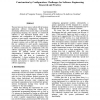Free Online Productivity Tools
i2Speak
i2Symbol
i2OCR
iTex2Img
iWeb2Print
iWeb2Shot
i2Type
iPdf2Split
iPdf2Merge
i2Bopomofo
i2Arabic
i2Style
i2Image
i2PDF
iLatex2Rtf
Sci2ools
ASWEC
2008
IEEE
2008
IEEE
Construction by Configuration: Challenges for Software Engineering Research and Practice
The past ten years have seen a radical shift in business application software development. Rather than developing software from scratch using a conventional programming language, the majority of commercial software is now developed through reuse – the adaptation and configuration of existing software systems to meet specific organizational requirements. The most widespread form of reuse is through the use of generic systems, such as ERP and COTS systems, that are configured to meet specific organizational requirements. In this paper, I discuss the implications of software construction by configuration (CbC) for software engineering. Based on our experience with systems for medical records and university administration, I highlight some of the issues and problems that can arise in ‘construction by configuration’. I discuss problems that arise in CbC projects and identify a number of challenges for research and practice to improve this approach to software engineering.
| Added | 29 May 2010 |
| Updated | 29 May 2010 |
| Type | Conference |
| Year | 2008 |
| Where | ASWEC |
| Authors | Ian Sommerville |
Comments (0)

